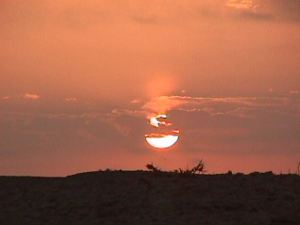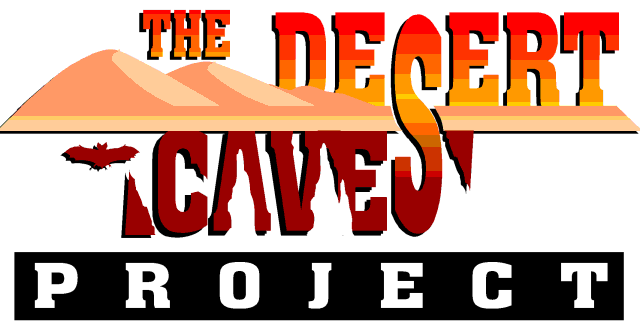FIELD TRIP TO SURPRISE AND FRIENDLY CAVES
©
2005 by John and Susy Pint
NOVEMBER 1-5, 2000
At 8:30 AM on Wednesday, November 1, 2000, four
of us - all members of the Saudi Geological Survey - headed for the
Jeddah airport, the plan being to fly to Riyadh where our two drivers
would be waiting for us with our expedition vehicles (driven all the
way from Jeddah!). My three companions were Mahmoud Al-Shanti, Mohammed
Al-Kaf (whose last name means "cave"!) and Saeed Al-Amoudi for whom
this would be his second trip to the big karst zone. Unfortunately,
Mohammed Halawani was off giving a conference and was unable to join
the expedition. This trip would give my three companions a chance to
put to the test the many days of Cave Exploration Training they had
undergone in trees and on rooftops in Jeddah.
At the airport, Security went through the Pint
bags with a fine-tooth comb. All that camera and caving gear looked
awfully suspicious! A letter stating that I work for the government
didn't help a bit.
We arrived in Riyadh around noon and found Lars Bjurstrom waiting for
us. A few hours later we were sliding around in the sand at the base of
the Aramco tower we use as a meeting place for the Dhahran cavers. We
had enough daylight left to calibrate our GPS's (I had 3 myself!) to
the Ain El Abd 1970 datum and to compare their readings.
Thanks to the wood Lars brought, we had
a nice campfire, and enjoyed tea and dates, bedu style. By 8:30 most of
us were already in bed, except for Greg Gregory of Aramco, who pulled
in around 2:00 AM, bringing with him a few drops of rain.
THE ROAD TO RUIN
We were up and about at 6 AM, even Greg, poor
soul, and soon on our way. At the lonely gas station between Rumah and
Shawiah we saw the bed being laid for a new stretch of blacktop heading
north. It looks like Shawiah will soon be connected by road and
reachable by one and all. Once word gets out and maps show this road,
the highly sensitive karst area will begin to receive visitors of all
kinds. Picnickers will be able to drive to Murubbeh Cave in a matter of
minutes and we can expect the traces of garbage inside to turn into
huge heaps. Some of the visitors may have flashlights and may discover
the 1000-year-old bones and the extremely delicate and unique "frosted
feather" formations. Will they admire them or take a handful home as
souvenirs? Another result of this road may be a dire need for a Cave
Rescue organization in Saudi Arabia. We may soon see desert explorers
trapped at the bottom of dahls. Unfortunately, at the moment there is
no organization in the country prepared to do cave rescues. It may be
time to think about how members of the Red Crescent or the Military
could be trained for rescuing... but, of course, the only way to train
cave rescuers is to start with experienced cavers. Here's a subject
that needs some thought. Meanwhile, the blacktop road is creeping
toward the caves!
We drove from Tower 1 to Shawiah, where we met a
group of the local citizens, including our old friend Faraj, a prince
of Shawiah who once helped us explore Dahl Iftakh. He and his friends
offered to help us find all the dahls we want.
REVISITING CAVE SITES
Next we drove to Murubbeh and began nailing down
the coordinates of a number of caves that we know best. Now that the
satellite signals are no longer distorted by the US Military, we can at
last enjoy real accuracy. We also went to several caves explored by the
UPM-Austrian team in the 1980s to see how good their coordinates are
(excellent!).
Late in the day we found Teapot cave,
which I could hardly recognize, as sand in that area has been blown
away and the entrance hole looks a lot bigger than I recall. The dahl
was blowing air, but unfortunately also the stink of rotting animals.
Soot on the shaft walls indicated someone had got a fire going in the
shaft or at the bottom... all signs that one of the prettiest caves
we've ever seen may no longer look the same. Dahl Sultan also has dead
animals at the bottom and it is clear that these special caves need to
be gated as soon as possible.
At last, we drove off to Lars' favorite
campsite among the dunes. Here we had an unexpected visitor: a very
large skink or sandfish that came to eat a scrap of tomato. He was so
busy nibbling on it that we could get in close for some fine pictures.
Then he dove back into the sand and "swam" away.
Our two vehicles got stuck in the sand a few
times until we finally let the air down to 15 lbs. Not having a strong,
reliable air compressor (like Lars's), our drivers opted for moving
camp to a less sandy spot. Everyone agreed you need a good tire pump
out in this territory. So, goodbye beautiful dunes!
TROGLOTERMITES?
With the GPS in the hands of my three
caver trainees, we found our way from the campsite to Dahl Surprise,
Saeed being the one who actually found the hole. Surprisingly, my el
cheapo Magellan Blazer 12 proved more accurate than the Garmin 12XL in
locating this spot! Next we rigged the hole with rope and cable ladder
and we all
rappelled in, including Lars, who, however, did not use the strange
"fat bar" rack he got from Mike Gibson.
We visited and photographed some of the
outstanding parts of Surprise, with the geologists noting many
features. For me, the big discovery of the day was that the ceiling of
the JAWS room is covered with termite tunnels. No termites were spotted
and one wonders how old the tunnels may be and what those termites used
to eat.
By the time everyone was out (giving all of us
good belay practice) and the cave was derigged, it was time for Lars
and Greg to depart and us to eat a quick lunch. This cave visit took
about five hours and all were enthused by Surprise's beauty.
Next, we went to Friendly Cave and hunted for a good campsite where we
could get some protection from the ever-increasing wind. Our crew set
up a big 4m by 4m canvas tent to protect sleepers from the wind, and
then we sat around the campfire drinking Mahmoud's chicken soup,
chatting and even holding an English class for
Saeed.
FRIENDLY SURVEY, UNFRIENDLY LIP
On Saturday, November 4, we rigged Friendly Cave, once again with both
rope and cable ladders and began surveying right from the top. We
thought this would be a short task, but at the far end of the cave we
found a passage that just kept on going, opening into ever larger
rooms.
Computer tape was strung all along, so someone had been there before
us. After several hours of surveying, we agreed it would be necessary
to return again to finish the job, and we took some time for
photographs.
Getting out of Friendly proved a challenge for my trainees, as we had
not practiced techniques for going over a lip with the cable ladder
pressed against a wall. However, all of them gave it their best effort
and we succeeded, especially with a little help from the strong arms of
Sa'ad, one of our drivers. There were lots of "bismillahs," sighs of
relief and slapping the back of each person once he got over the tricky
lip. I think this ascent convinced everyone that we are involved in a
game of life and death where we can't afford to make mistakes.
CHECKING ALTITUDE
After another of Mahmoud's unforgettable soups, we did an altitude
check by finding spots on the map and comparing the GPS version of the
altitude (which proved 20 meters too high). We also had just enough
time to go look for Dahl Abu
Marwah. We had seen it on our 1:50,000 topo map and knew it was close,
so we calculated its location on the map, keyed this into the GPS and
voila! we drove straight to the famous old hole. On our way back to
camp we spotted a curious dahl with two openings like the "eyes" of a
mask. We planned to check out "EYES" the next morning, but it was not
to be.
On returning to camp, the wind started in seriously. First we put up
tarps against a barrier made by the two trucks, but soon it was
necessary to move the kitchen into the sleeping tent where we enjoyed a
supper of tuna fish, tomatoes, halwah and honey. By this time it was
really howling outside. Sand filled the air and Mohammed had problems
breathing due to an allergy. My little tent, held in place by the same
kind of sturdy pegs used for the bedu tent, was stretched to the
breaking point, relentlessly sand-blasted. Yes, it was a real Shamal
and we suspected a heavy rain might be right behind all the blowing
sand, which would be bad news, since the bedu tent is not waterproof
and only I had a poncho. On top of that, our tarps were all torn up by
the wind, so there was no way to cover either the food or people.
Amazingly, my tent held strong all night, even though I got a
head-to-foot sand "bath."
SUNDAY SHAMAL
To my surprise, sunrise brought no calm, but ever
stronger winds and the first drops of rain. We canceled all exploration
plans, realizing that a full-blown shamal could leave us stranded and a
rain storm would be a disaster, since only one person had brought along
a poncho (guess who?) and the only tarps we had with us had been ripped
to shreds during the long night.
With Mahmoud's good eye (He could see Shawiah's tower from just beyond
our camp, while I saw nothing) and two GPS's we had no problem reaching
Shawiah, which we entered via a hard-packed, rough gravel road which
lies just east of the tricky, slipsliding track over the dunes that we
normally used. Thus, we zipped through Shawiah and headed across the
long stretch to THE gas station. Smooth going, but at one point the GPS
proved very useful.
Finding the Riyadh airport could have been more
difficult than navigating the desert, but our map demonstrated
that we could get to the airport without entering Riyadh at all. On our
way back, we discussed what we had learned on this trip. My companions
emphasized that getting out into the caves was a real eye-opener
allowing them to see the realities and dangers they must face in a way
that just doesn't come across through slides or climbing practice in
trees.
I mentioned to Mahmoud that it was too bad
Ramadan was approaching and there wouldn't be time for another cave
trip before then. "Why not?" he asked. "We can squeeze in one more
trip, no problem." I was delighted to see this spirit after a hard trip
and we immediately began planning the next expedition.
John Pint
November 12, 2000

|

















